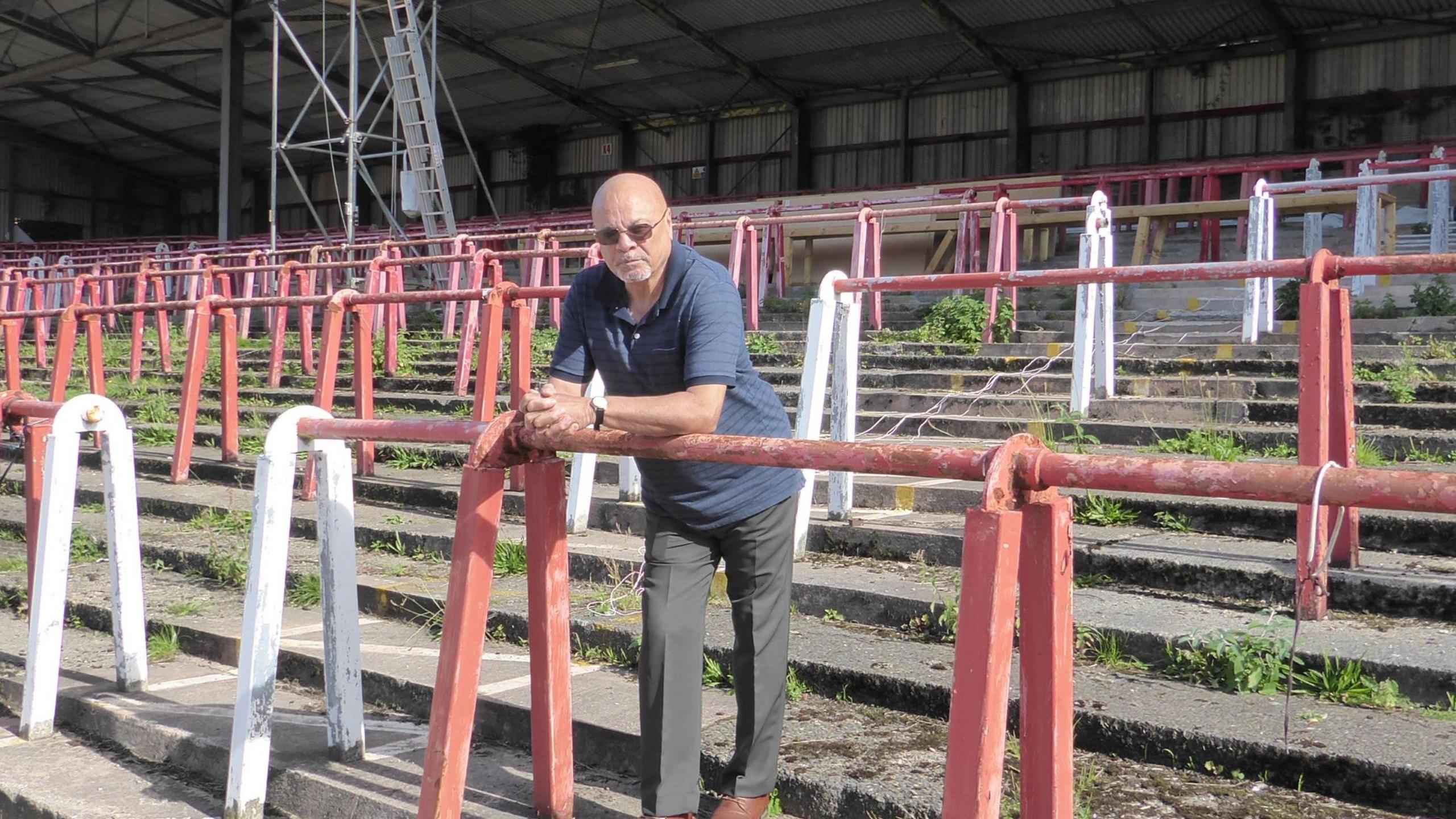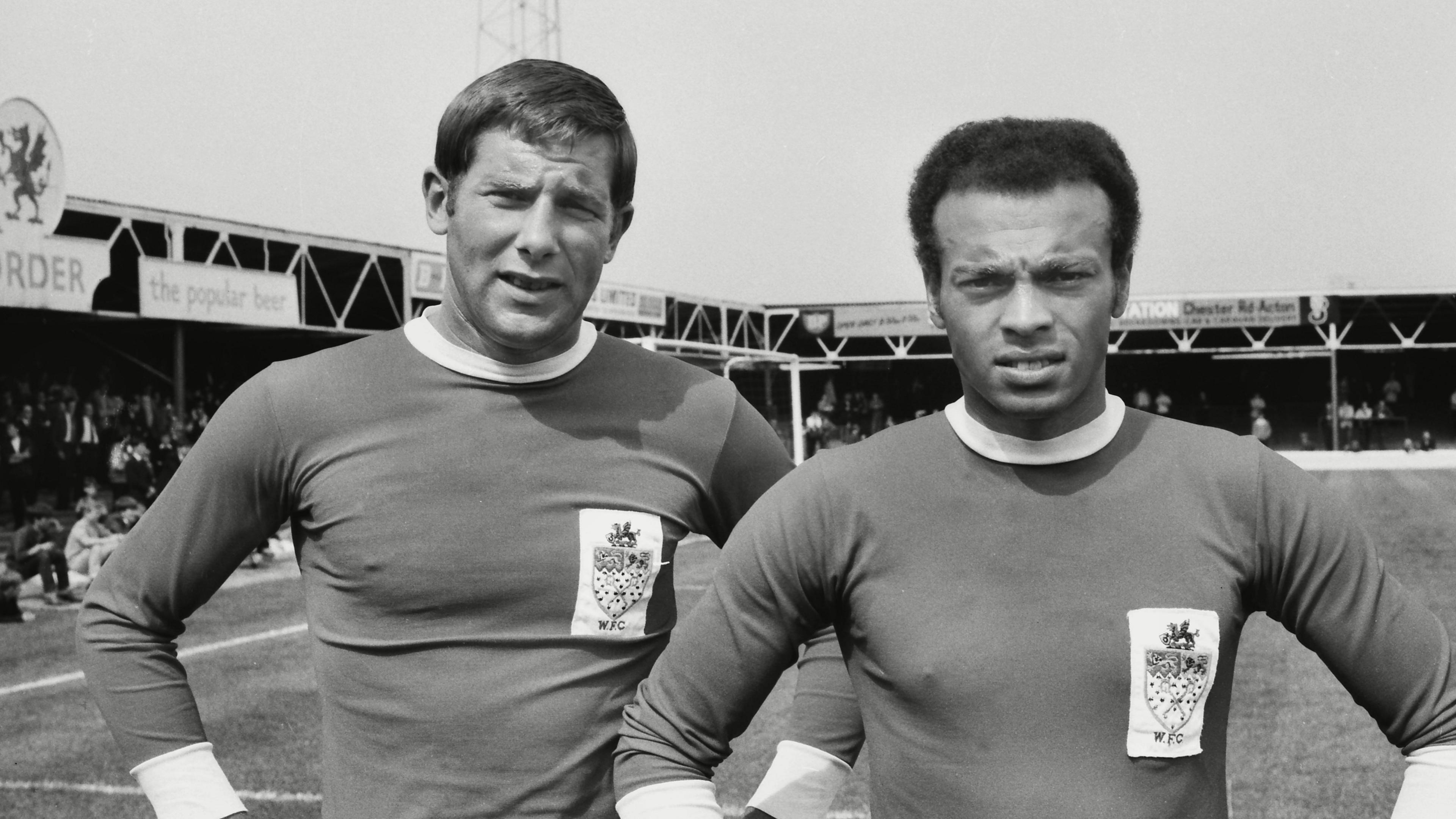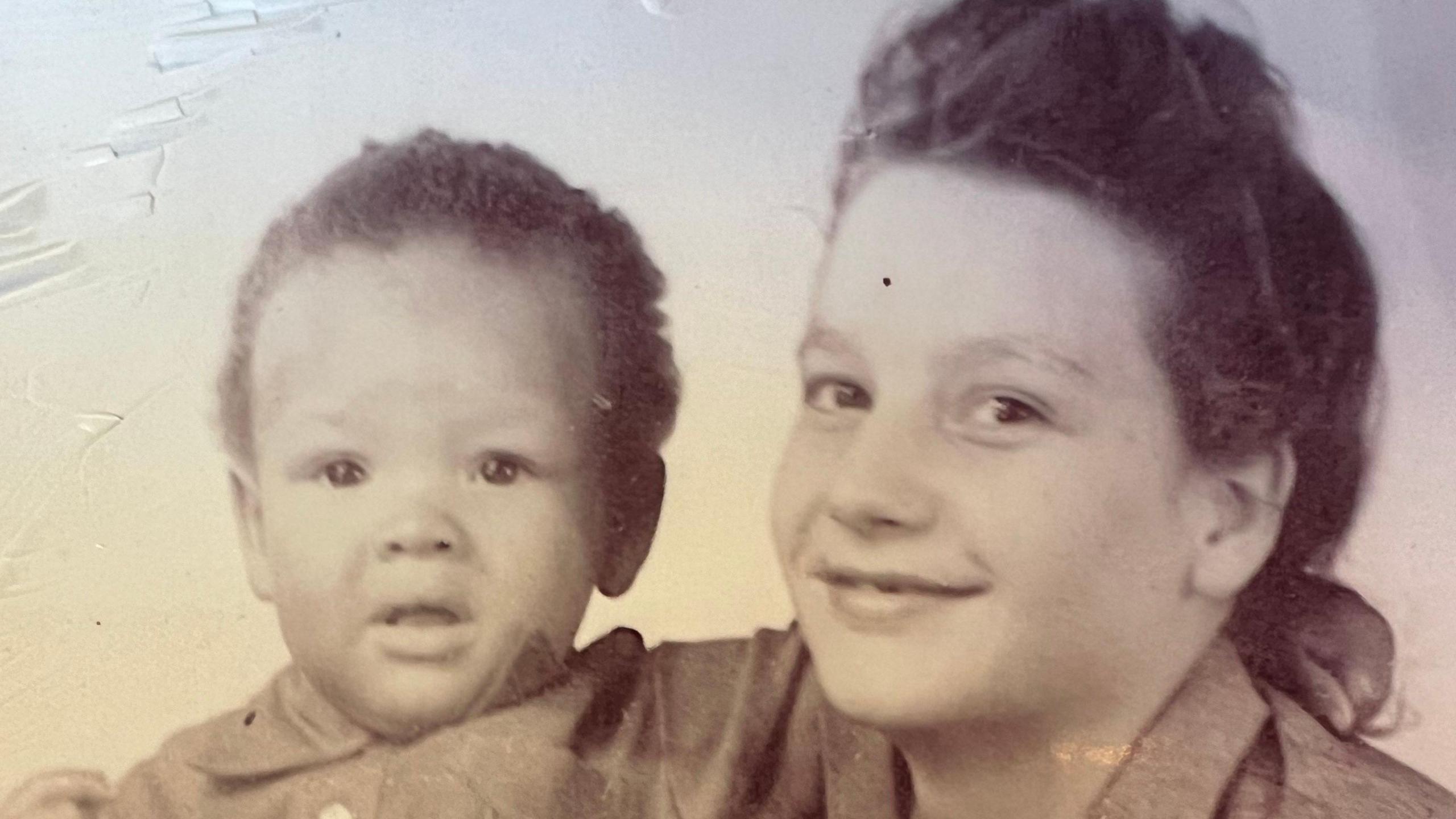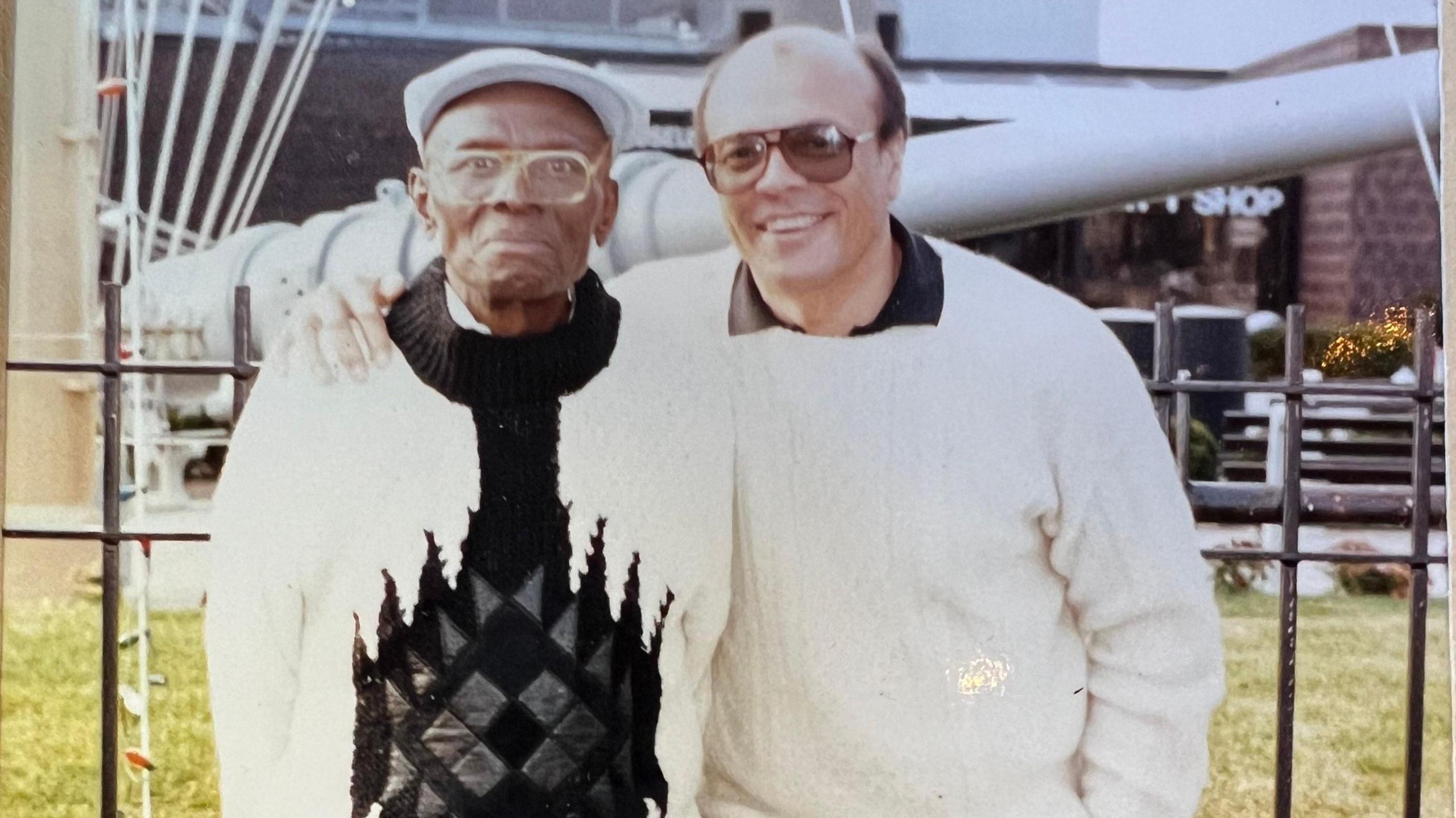The black football pioneer with a story worthy of Hollywood

Steve Stacey - who returned to visit Wrexham in 2019 - played a key role in British football's black history
- Published
Warning: This article contains reference to incidents of racism
"They should get Denzel to play you, Pops."
Steve Stacey offers a satisfied laugh of approval to his grandson’s suggestion.
They have certainly got the casting connections at Wrexham these days. Ever since Ryan Reynolds and Rob McElhenney arrived at the Racecourse it feels half of Hollywood have been taken in by the club’s story.
But prior to red carpets along the Mold Road, there was the path walked by Stacey. One that linked North America and north Wales long before the A-listers, one that began in the racial divide of the Deep South and made its way to Wrexham via the gas-lit streets of post-war Bristol.
All of which led to Stacey, the son of a black GI, becoming the first footballer of African-American descent to play professionally in the English football leagues when he made his first of 119 Wrexham appearances in February 1966.
It also took him to Ipswich Town, where he would become the club’s first black player, as he was at Charlton Athletic and Exeter City too.
And ultimately it led him to an emotional reunion with the father he thought was dead, and the family who had known little of the milestones made by their long-lost relative far away from their Mississippi home.
'All that mattered was if you could play'

Stacey signed for Wrexham in 1966, pictured here two years later alongside future Cardiff City manager Eddie May
In another life, it would have been Stacey’s home too.
His mother, Evelyn, had been 19 when she met Clarence Lee Sims of Kemper County. He had been one of the 240,000 African-Americans among the three million US troops stationed in the UK over the course of World War II.
Meeting in a local pub, not far from the Muller Orphanage that had served as US barracks, they had fallen in love. Steve was to become what the media would dub the war’s 'brown babies', one of around 2,000 children born to white British women and black American GIs.
Marriage between a white and black person was still illegal in many American states, and was a permission denied by Clarence’s – white – unit leader. The prospect of leaving for the US after the war when Clarence was sent home was raised, but never an option as far as Stacey’s mother was concerned.
"She knew what it would have been like," Stacey, now 80, tells BBC Sport Wales, his Bristolian accent still proudly strong despite speaking from Australia where he has lived for the past four decades.
Strong is also how he describes his mother. It was she, with the help of his grandmother, who brought him up despite the inevitable glances, or worse, from disapprovers. Many 'brown babies' were sent away with little chance of adoption, and faced difficulties through life.

Steve Stacey, born in 1944, says he will forever be grateful for the strength and bravery of his mother Evelyn
Stacey knows he was fortunate and says he faced little overt racism, although you wonder if what shielded him, perhaps saved him even, was his skill.
"You have to remember, this was just after the war," says Stacey. "I wasn’t the only one growing up without a father. Everyone had suffered loss one way or the other.
"Everybody just enjoyed being with themselves. I felt completely at home. No-one cared what colour you were when you were playing 20-a-side on the streets."
Indeed, in his emotional and evocative autobiography entitled 'The Colour of Football', Stacey wonders if being selected as team-picking captain in those street matches was one of the most important moments in his life. The best player is the best player – and colour played no part.
It had not when he was signed by Bristol City as a 16-year-old after progressing from the street and the park, nor when he was signed by Wrexham five years later where he finally got his first-team opportunities.
"When you were in the dressing room, the bunch of lads together, the only thing that mattered was if you could play," he says. "I never had anyone from my teams say any of those words."
There were words from the odd opponent – "one had me round the neck and called me a whatever so and so, but I just gave him an elbow" – and Stacey insists he rarely paid attention to what the crowds may or may not have been saying, preferring to focus on the game and the man he was marking.
Tommy Best: Forgotten black football pioneer
- Published30 October 2023
The forgotten story of Eddie Parris, Wales' first black footballer
- Published18 October 2020
The best of BBC Sport during Black History Month
- Published1 November 2020
Some things are hard to ignore, though.
"I can remember we had a large bay window and our daughter Michele playing with her toys," says Dot, Stacey's wife of more than 60 years. "She came from behind her toys and she had covered herself in talcum powder, saying maybe a couple of her friends would play with her now she was white. I went straight to their mothers. That doesn’t come out of a child’s mouth."
Such passed-down poison, however, did not detract from the joy Stacey says the family had living in Wrexham, teasing eldest daughter Michele that she had developed a Welsh accent.
"We loved living there," he says. "You really felt part of the club and the community."
And while Stacey would write that there were times were there was a loneliness -only twice in his career would he share a dressing room with another black player - and a sense of being unable to share some experiences of being "different", his gratitude of being able to play the game he loved and provide for his family meant more.
What he could not shake, though, was that wondering about his father.
Sympathy from Shankly

Pictured here in August 1968, Stacey played alongside the likes of 100-goal striker Albert Kinsey (to his right) in his time at the Racecourse
Stacey would spend almost three years at Wrexham, promotion eluding the then fourth-tier team as they sold player after player. A speedy right-footed left-back – first nicknamed 'Flash' by the groundstaff back in Bristol – his ability was perhaps best displayed by the fact he wore close to every number in a Wrexham shirt, playing in every position, even pressed into emergency goalkeeping after developing those skills back in the street-game days.
Ipswich signed him to play centre-half in the First Division, paying £25,000 in September 1968 and he made his debut against Liverpool. It lasted 30 minutes before injury ended his afternoon, earning the sympathy of Bill Shankly in conversation on the train back to London.
A hamstring problem would mar the remainder of his career, leaving Portman Road during the early days of Sir Bobby Robson’s tenure. He was sent on loan to Charlton, returned to Bristol City and moved to Exeter before dropping into non-league with Bath City. Then, after a suggestion from former Southampton striker John Sydenham, he went to Australia to first play, then coach, then work and live.
It was there that Michele and second daughter Nat began their questions about their heritage, prompting Stacey into finding his father.

What would Stacey think of playing under Hollywood owners at Wrexham? "I'd like to think it would be more than the £4 win bonus I was on there!"
"For a long time dad had thought he was dead," Michele recalls.
For years Stacey and his mother believed he had perished. A Sunday newspaper magazine displayed striking photographs from around the world, including one of a man captioned as Clarence Sims jumping off a bridge. Stacey finally got hold of the image and showed it to Evelyn, who assured him it was the wrong man.
She was right.
"The army had not been very helpful," Stacey says, with the records of black conscripts from the areas Clarence came from not always the most carefully recorded. "We hired someone to track him down. When she found him and told him his son in Australia wanted to speak to him, he told her his son was from England. He knew all about me."
Perhaps not his life as a footballing pioneer, though.
Stacey visited the father he could not remember but had long imagined, spending time in Kemper County, visiting the nearby town of Meridian, the home of the Mississippi Burning trials.
"It still didn’t feel like a place for a black man to be, but all I cared about was finding my father," he says, angered by the stories of the area’s past, grateful again of being born in a different place and his mother’s bravery in bringing him up.

Stacey eventually reunited with Clarence. He said he instantly was made to feel part of his rediscovered American family
Evelyn and Clarence had initially managed to stay in touch in the early years of their son’s life before contact was lost. These were not the days of mobile phones and messaging.
Times are different now. Stacey remains in contact with his American family, and wonders whether the Hollywood interest in his former club has reached them. There is every chance.
"When I’d speak about Pop's clubs I’d start with Ipswich and go back – and no-one would know who Wrexham were by the time I’d get to them," smiles grandson Alex, who admits to being a big 'Always Sunny in Philadelpia' fan - the sitcom created by McElhenney.
Not so now, with Stacey having played a significant part in a history too often overlooked.
He plans to return to take in a game having last done so in 2019 before the recent Hollywood rise, though adds: "The problem is sitting in the stands. I still want to be out there playing!"
With his tale worthy of the scripts Wrexham are associated with these days, the question is who plays Steve Stacey?